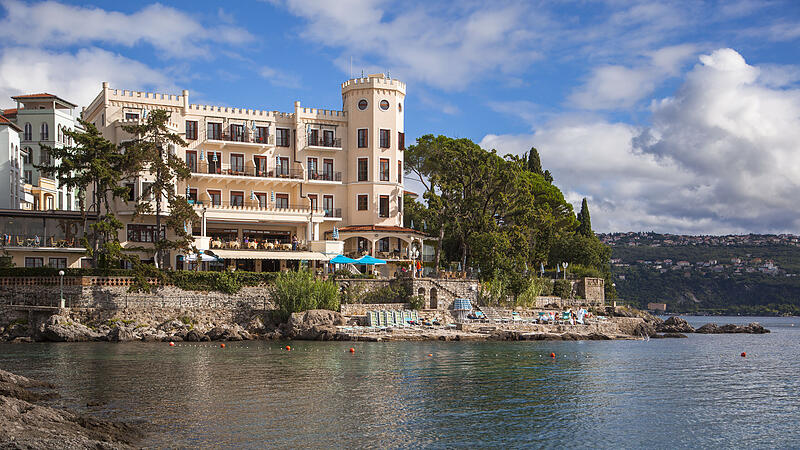Luxury was once a matter of course on the “Austrian Riviera”, as the Croatian Kvarner region was advertised in large format in 1909 in the “Alpenzeitung”. From the imperial court down, nobility and the upper classes from all crown lands and from the rest of Europe resided mainly in winter in the former fishing village with the abbey (Abbazia, Opatija), which later gave the town its name.
People lived in grand hotels or villas, also mainly designed by Viennese architects, with their own stately households. Restaurants and cafés in the current style of the imperial capital of Vienna created the usual exclusive atmosphere.
The air enriched with sea salt aerosols healed the lungs when strolling along the near-sea Lungomare, now known as the Kaiser-Franz-Joseph-Promenade. Spa treatments did the rest. Maria Anna, the wife of Emperor Franz Joseph’s predecessor Ferdinand, loved staying here from 1860, later the heir to the throne Rudolf and his wife Stephanie came to the playground of Europe’s social elite, which was soon to be declared a “climatic health resort” by imperial decree.
Emperor Franz Joseph met Kaiser Wilhelm here, and other royal highnesses followed. The engine of the whole thing was the Austrian Südbahngesellschaft, whose trains were able to drop off the noble guests near Abbazia and which was the largest investor in the boom years. From the 1880s onwards, grand hotels, noble villas, spa houses and later bathing establishments in the bays were built.


The noble magic was over by 1918 at the latest, the Opatija Riviera was added to Italy and suffered from the disappearance of many wealthy visitors. After the Second World War, the former world health resort became part of communist Yugoslavia, which let the old flair fade but, like the entire region, made it possible for millions of Europeans to take their first affordable vacations by the sea.
Renaissance in the new Croatia
After the breakup of Yugoslavia, accompanied by war, the Croatian city, like the entire Kvarner region, continued the old success story, with the difference that there is an offer for a wide variety of holiday needs. From the mid-1990s, an Austrian took on the investment risk in the post-communist country despite the difficult legal situation: Wilfried Holleis, head of the Holleis hotel group from Zell am See, built the former Villa Meyne, which was built in the Imperial and Royal period and is very close to the sea to the Adria Relax Resort Miramar.
Old Austria and Adriatic flair
Like the style of the villa, the name is reminiscent of the Miramare Castle in Trieste, which Maximilian, the brother of Emperor Franz Joseph, had built before his fatal adventure as Emperor of Mexico. The 4-star hotel with a great view of the intensely blue sea combines Austrian nostalgia with Adriatic flair, Sachertorte and Kaiserschmarren with Croatian Adriatic cuisine. Many of the magnificent Gründerzeit villas have been renovated, as have the old hotels, but there were also one or two concrete blocks.
A project in an unusual place presents itself quite differently: the Hotel Navis, which was built on the cliffs of a bay. The house looks like a futuristic swallow’s nest with its five floors stacked on top of each other, each room has a panoramic window, the king-size beds are arranged in such a way that the first thing you see when you wake up is the sea.
Like many hotels in the Kvarner, the Kapetanovic family that owns it also relies on what is called “fine dining” in modern German. The restaurant has now been awarded two toques in the Croatian Gault Millau.
Fine dining in the cliff hotel
In the Kvarner region, gourmet cuisine can draw on plenty when it comes to quality goods such as olive oil, vegetables, fish or meat (lamb). The scampi, of which the people there say that they are the best in the world, are a fixed part of the program, whether as carpaccio, tartare or in the cappelletti called ravioli. Also on the menu: calamari with sautéed spinach and cream from “Krumpir”. The latter comes from the Old Austrian word for potato, Grundbirn(e).
The island of Cres is the most natural of the Kvarner islands. It owes its first boost to tourism to Crown Prince Rudolf, who was enthusiastic about the hunting opportunities there and who also described Cres, then known as Cher, in the encyclopedia he co-authored about the monarchy.
The adjoining island of Losinj, then mostly called Lussin(o), experienced a new boom as a climatic health resort after Archduke Karl Stephan bought a captain’s house on Veli Losinj and Austrian doctors praised the healing powers of the sea air and the untouched nature.
Losinj: Innviertler brought star
Today Mali Losinj is the more important place. Campers, family vacationers and boat captains are drawn to the mild, subtropical, healthy climate. The idyllic Cikat Bay, where the celebrities had villas built in the old days, is still a place for the highest demands today. Of course, recently there has been criticism of the influence of Russian investors.


Three 5-star hotels – with the elegantly redesigned “Bellevue” as the largest house – provide accommodation with the highest level of comfort. In one of them, the boutique hotel Alhambra, there is a young Innviertel chef. After only four months, Michael Gollenz cooked up the first Croatian Michelin star for Losinj for the restaurant, named after the Austrian architect of the former Villa Alhambra, Alfred Keller.
The son of a chef, who comes from Hochburg-Ach in the Braunau district, was surprised to have come this far at the age of 26. Although: Gollenz, who trained in Salzburg and became a top chef in Zurich, had the ambition to one day be “one of the better” in the industry early on. In Switzerland, he learned French cooking techniques with international, often Asian influences at a high level. And he can celebrate that here – supplied by fishermen, sheep farmers and olive farmers.
Source: Nachrichten




